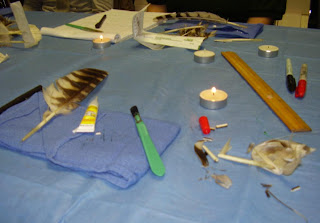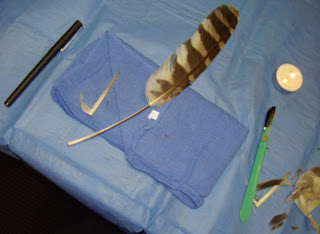Facultative rabies
(Facultative: capable of adapting to different environmental conditions)
Well, this past week can be taken out back and shot, as far as I'm concerned.
Isadora had been sick with kidney disease and an upper-respiratory infection for a little while, but we thought we had it under control. She was getting fluids intravenously, and we had a plan for when she resumed eating, and how we would manage her kidney disease--the prognosis seemed good.
Since our vet clinic is not an emergency facility, and no doctor is present on the weekend, I got a call from the vet Friday a week ago, suggesting I take her home and provide hands-on care Saturday and Sunday--syringe feeding and subcutaneous fluids--and then bring her in Monday to restart the IV. Sounded like a plan--I was going to attend the Western Washington Wildlife Rehabilitators conference at the UW Saturday, but I could be a little late to that, np--so that's how we proceeded. I picked up Izzy, subq-fluided her, and then left for the conference. When I got back that evening, we did the same routine plus a syringe feeding.
Sunday, same deal. That's when she decided she'd had enough of this crap, and bit me in the right index finger knuckle, HARD! I think I'm going to have a scar from it.
By Monday morning, it was red, hot, and so swollen it had that Botox look: no natural wrinkles anymore; half of the back of my hand was almost perfectly flat and fluid-filled. And it hurt like a bastard! We're uninsured at the moment, due to unemployment, so I don't routinely go to the doctor, but I wasn't about to let this infection go systemic, either, so it was off to the emergency room for me.
I dropped Izzy off at the vet's on the way to the ER, and warned them about her biting me. We actually have observed this behavior, called "The Cobra", in the past: when she feels bad and over-interfered with, she bites swiftly and hard, without warning, compared to the absolute lovecat she always is when she feels better. Since she gives no warning, I didn't want anyone else taken by surprise.
The visit to the Overlake ER was the best it could be, given the circumstances--it's an ER, after all, nobody's idea of a good time (I hope!). But the staff was competent and kind, and since no gunshot wounds or anything like that were coming in, I was able to be seen right away. The nurse practitioner who saw me was friendly and patient, and willing to answer questions. She thought it was a Bordetella infection, and although penicillin is the first line against that infection, the almost-fact that I am allergic to penicillin made doxycycline the recommended way to go.

Figure 1: Image of Bordetella bronchiseptica from http://upload.wikimedia.org/wikipedia/commons/thumb/1/1d/Bordetella_bronchiseptica_02.jpg/240px-Bordetella_bronchiseptica_02.jpg

Figure 2: Doxycycline, related to tetracycline
With a sling to immobilize my dominant hand (to remind me not to use it anymore than necessary), and a container of antibiotics, I headed home. I had just gotten settled in when the phone rang. It was the vet, and she asked me some questions about the bite. Then she said she had some bad news, and I knew before she told me that Isadora had died.
We're all shocked--we thought she was getting over this upper respiratory thing, and would go on to have her kidney disease successfully managed. She thought so, I thought so, Iain thought so--but whatever it was she had, it was too much for her.
Well, that was bad enough. But wait, there's more!
It turns out that King County has a "rabies protocol" that automatically kicks in when an animal bites a human, and then dies shortly after. She had to report it to the public health department, and was waiting to hear back from them whether they needed to get Izzy's head to test the brain for rabies.
She did the right thing in invoking the protocol, even though I'm (almost) sure we're in the clear. I'm just neurotic enough to worry about the tiny possibility of it, even though we agree she showed no signs of rabies either here or at the clinic, and her staggering was plausibly due to her weakness in not eating for so long, rather than the neurological degeneration of rabies. Her "flu-like symptoms" are more consistent with an upper-respiratory-tract infection than the symptoms Wikipedia's entry on rabies describes, and the bite was far from unprovoked. I was bugging her with syringes and needles, and "The Cobra" goes back for years now.
It looks like the public health department is going to agree with us, and not insist on testing. So that's that, except for the next couple of years, in my more paranoid moments, I guess I'll be interpreting every little sneeze or shiver as the onset of my own personal rabies case.
I told a conservationist friend, and said that, just in case, I was preparing a list of people to bite </oldjoke>. "Facultative rabies", she proposed. I like that.
Labels: animals, family, friends, infectious disease
Read more!









